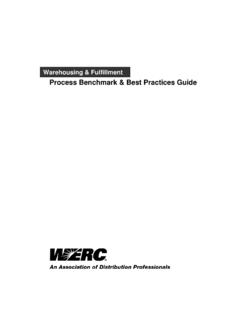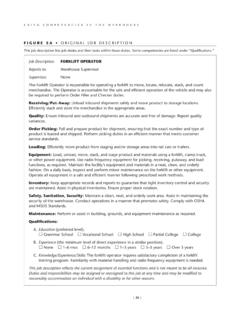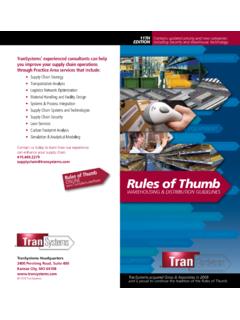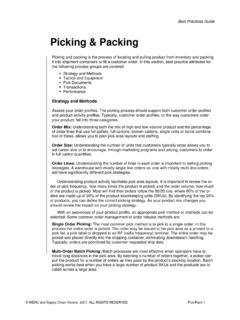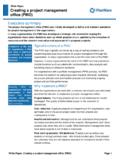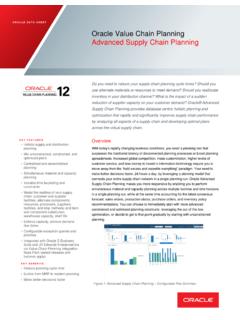Transcription of Cornerstone Solutions, Inc. - WERC
1 Cornerstone solutions , Inc. Top 10 Supply Chain best practices Going all the way back to the third grade, we all can remember at least one of our teachers saying something like just be the best that you can be! And still today, we put that mentality into practice. In business, profits come through efficiency. There lies the concept that even when everything around us is running smoothly, we should do our best to make it run even better. So why not try to become more efficient? Why not, Do your best ? All businesses, from manufacturing warehouses to service oriented firms, strive to be the best at what they do. Each one of us wants to know how to do the best in our marketplace. But how do we measure success? What does it look like? That's where best practices comes in. We can usually look at the performance of similar companies to get answers to these questions.
2 Before we get into what the best practices are that we should be implementing, let's go through what a supply chain is and why supply chain management is so important for your company. From a high level, a supply chain really consists of four major areas, none being more important than another. They are: Plan, Source, Make, and Deliver. Planning consists of areas like demand forecasting, inventory management and product pricing. Sourcing involves purchasing, vendors, and policies and practices . Making is fairly straight forward with things like product design and scheduling and facility management. Delivering looks at the areas of order management, delivery schedules and returns. Supply Chain Management (SCM) takes the supply chain a step further and looks at the process of optimization. SCM optimizes all four areas of the supply chain by minimizing inventory, reducing costs, increasing production and rapid order fulfillment.
3 These areas can be measured and compared to self . assessments made by others in the field. However, there are dozens of best practices in a supply chain and when researching the variety of solutions available, we could ultimately lose focus on the primary goal of looking for tools to improve our operations. With this in mind, let's simply look at the top ten best practices , and organize them into the four areas of a supply chain. Plan Forecasting lays the groundwork for SC Planning and requires all departments to come to a clearly defined goal, based upon historical data as well as current rates of sales, supply and demand, etc. And as with all data measurements, accuracy is key. In other words, use pre determined guidelines, or a specific forecasting method, so when information is received from every department such as sales, purchasing and receivables they can be put together like the pieces of a puzzle to result in a truly accurate forecasting number.
4 Collaboration, first internally, is a best practice because sharing information within an organization, as well as with suppliers and customers (as will be discussed later), is vital to its success. People make an organization successful, and if people do not communicate often and openly, it can undermine your Executive Summary desire to create an environment of teamwork. For example, all departments need to be aware of equipment or software changes to help implementation run efficiently. During such times, each employee needs to share his or her knowledge with the rest of the organization so everyone will continue working effectively as well. Measuring with Metrics, or the use of Key Performance Indicators (KPI) tells you how you are performing, and can be very useful, but very confusing at the same time. Many of these metrics, including inventory carrying costs, cash to cash cycle time, fill rates, etc.
5 ; can provide companies with valuable details into their efficiency. However, the confusion lies with data contradictions and the possibility of data inaccuracy. Working with a set of standard indicators can be helpful. Performance metrics used by companies such as SCOR (Supply Chain Operations Reference) can offer supply chain analysis specifically designed for your industry. A customized set of KPI's, or industry specific benchmarks, will provide a roadmap for measuring your metrics, which will in turn show you where improvements are needed. Source Logistics Operations should be clear, yet flexible, to achieve competitive supply chain performance. Flexibility in logistics involves the ability to reconfigure operations to meet fluctuating customer demands. Be sure to support your pre defined operations requirements, but be ready and able to change, looking into operational improvements place and business operations run smoothly.
6 Supplies come in on time, products are then created efficiently, orders are filled accurately and customers are happy. Order Fulfillment is priority one, as this puts your product on the shelf so that customers can make purchases. Value Added Services that offer customization and differentiation can increase an already high level of customer satisfaction, perhaps bring additional revenue to your bottom line, and proves you have an eye on the future. Make Technology is important to automate warehouse activities and ultimately fulfill today's consumer needs. For example, one of the main technologies used in warehouses today is a Warehouse Management System (WMS). A WMS provides many benefits beyond automation. Speeding up processes and making a warehouse less prone to errors does save time and money. Savings are initially realized, of course, in minimized touch labor and inventory reduction.
7 However, premium freight expenses, reverse logistics costs, and restocking time are less recognizable savings but just as important. WMS technology also offers greater visibility into Facility Management. What is the capacity of each facility? Which products should be allocated to each facility? Technology can clearly meet the needs of the most critical Facility Management techniques. Other technology that offers a competitive edge is implementing an Order Tracking System, available with a WMS. This allows users to view when a customer ordered an item and when the item was actually shipped. Another benefit to order tracking is allowing visibility at the customer level as well, by giving them the opportunity to track orders online, down to the line item level. 2007 l All rights reserved l Cornerstone solutions , Inc. l l Executive Summary Lean and Agile Manufacturing can be defined individually based upon a company's role in the market.
8 Lean manufacturing is ultimate inventory reduction, using the just in time approach to reduce inventory levels as close to zero as possible. Leanness makes the most sense for organizations when variety is not required, demand is predictable, and product volume levels are high. Agile Manufacturing can be defined as manufacturing flexibility. Agility refers to a company's ability to respond quickly to changes in customer demand. This works especially well when volume is low and requirement for variety is high. Product Scheduling is a very important facet of manufacturing, ensuring that a balance is met between high utilization rates, low levels of inventory, and high levels of customer service. Deliver External Collaboration looks at the relationships with partners, suppliers and the all important customer. Communication with customers is vital, for the sole purpose of understanding the customer's needs and wants so organizations continue selling products.
9 Organizations that stay in touch with partners and suppliers are much more likely to receive products in time to produce and/or fill the customer orders in real time. This can come through data integration, as well as simply sharing a strategy that brings products and information together to get the product delivered when and where it is needed. Information Technology can create a Virtual Supply Chain, where data is captured on demand, thus increasing transparency of the entire supply chain. Value Chain is a process whereby the corporation passes value on to the customer, with the least possible cost to the business. Value Chain provides businesses with a competitive advantage. Value comes in many areas, such as clear order management. Order management becomes efficient when orders are only entered once, automated order routing is in place, order status is visible throughout the chain, and an integrated order management system is functioning.
10 When the utmost goals of any business are profit and customer satisfaction, value is the top priority when it benefits both the customer and the corporation. Reverse Logistics, also known as Return Processing, should be considered when accurately measuring cycle time metrics. Inevitably, there will be a flow of products back to the vendors and suppliers, when items are defective, unsatisfactory, and for reuse or recycling. Companies that do not forecast for reverse logistics may pay a very high price; first in lower levels of customer service and increased labor activities, but ultimately with reduced revenue. Success with reverse logistics comes by creating a return process that is clear and concise, and that minimizes errors for both the consumer as well as the employee. Delivery Scheduling introduces the Distribution Center (DC) and Third Party Logistics (3PL).
